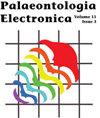灵长类动物差异的25个合理的化石校准
IF 1.5
4区 地球科学
Q1 Earth and Planetary Sciences
引用次数: 4
摘要
系统发育与分化时间的估计对于研究许多进化问题是必不可少的。原则上,“尖端测年”可以说是最合适的方法,化石和现存的分类群在一次分析中一起分析,同时估计拓扑结构和分化时间。然而,“节点测年”(在许多分子钟分析中使用),其中使用化石证据来先验地校准特定节点的年龄,可能仍然是主要的方法,因为同时分析形态学和分子数据存在各种问题。在这里,我们提供了灵长类分化的25个合理的节点校准列表,遵循最佳实践:Haplorhini中有16个,Strepsirrhini中有4个,crown灵长类中有1个,euarchontoglies中有4个更老的分化。在每种情况下,我们都提供了一个硬最小界,对于其中的22种情况,我们还提供了一个软最大界和一个建议的先验分布。对于每个校准的节点,我们提供了每个子谱系中最古老的化石的年龄,这允许使用“枝龄”方法来指定节点年龄的先验。多里安·德·弗里斯。英国曼彻斯特索尔福德大学科学、工程与环境学院生态系统与环境研究中心。(通讯作者)d.devries@salford.ac.uk @PaleoDorien Robin M.D. Beck。英国曼彻斯特索尔福德大学科学、工程与环境学院生态系统与环境研究中心。r.m.d.beck@salford.ac.uk @robinmdbeck本文章由计算机程序翻译,如有差异,请以英文原文为准。
Twenty-five well-justified fossil calibrations for primate divergences
Phylogenies with estimates of divergence times are essential for investigating many evolutionary questions. In principle, “tip-dating” is arguably the most appropriate approach, with fossil and extant taxa analysed together in a single analysis, and topology and divergence times estimated simultaneously. However, “node-dating” (as used in many molecular clock analyses), in which fossil evidence is used to calibrate the age of particular nodes a priori, will probably remain the dominant approach, due to various issues with analysing morphological and molecular data together. Here, we provide a list of 25 well-justified node calibrations for primate divergences, following best practices: 16 within Haplorhini, four within Strepsirrhini, one for crown Primates, and four for older divergences within Euarchontoglires. In each case, we provide a hard minimum bound, and for 22 of these we also provide a soft maximum bound and a suggested prior distribution. For each calibrated node, we provide the age of the oldest fossil of each daughter lineage that descends from it, which allows use of the “CladeAge” method for specifying priors on node ages. Dorien de Vries. Ecosystems and Environment Research Centre, School of Science, Engineering and Environment, University of Salford, Manchester, UK. (Corresponding author) d.devries@salford.ac.uk @PaleoDorien Robin M.D. Beck. Ecosystems and Environment Research Centre, School of Science, Engineering and Environment, University of Salford, Manchester, UK. r.m.d.beck@salford.ac.uk @robinmdbeck
求助全文
通过发布文献求助,成功后即可免费获取论文全文。
去求助
来源期刊

Palaeontologia Electronica
地学-古生物学
CiteScore
3.60
自引率
0.00%
发文量
20
审稿时长
>12 weeks
期刊介绍:
Founded in 1997, Palaeontologia Electronica (PE) is the longest running open-access, peer-reviewed electronic journal and covers all aspects of palaeontology. PE uses an external double-blind peer review system for all manuscripts. Copyright of scientific papers is held by one of the three sponsoring professional societies at the author''s choice. Reviews, commentaries, and other material is placed in the public domain. PE papers comply with regulations for taxonomic nomenclature established in the International Code of Zoological Nomenclature and the International Code of Nomenclature for Algae, Fungi, and Plants.
 求助内容:
求助内容: 应助结果提醒方式:
应助结果提醒方式:


